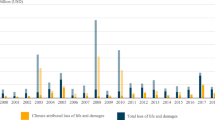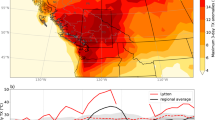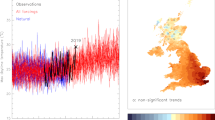Abstract
Interest in attributing the risk of damaging weather-related events to anthropogenic climate change is increasing1. Yet climate models used to study the attribution problem typically do not resolve the weather systems associated with damaging events2 such as the UK floods of October and November 2000. Occurring during the wettest autumn in England and Wales since records began in 17663,4, these floods damaged nearly 10,000 properties across that region, disrupted services severely, and caused insured losses estimated at £1.3 billion (refs 5, 6). Although the flooding was deemed a ‘wake-up call’ to the impacts of climate change at the time7, such claims are typically supported only by general thermodynamic arguments that suggest increased extreme precipitation under global warming, but fail8,9 to account fully for the complex hydrometeorology4,10 associated with flooding. Here we present a multi-step, physically based ‘probabilistic event attribution’ framework showing that it is very likely that global anthropogenic greenhouse gas emissions substantially increased the risk of flood occurrence in England and Wales in autumn 2000. Using publicly volunteered distributed computing11,12, we generate several thousand seasonal-forecast-resolution climate model simulations of autumn 2000 weather, both under realistic conditions, and under conditions as they might have been had these greenhouse gas emissions and the resulting large-scale warming never occurred. Results are fed into a precipitation-runoff model that is used to simulate severe daily river runoff events in England and Wales (proxy indicators of flood events). The precise magnitude of the anthropogenic contribution remains uncertain, but in nine out of ten cases our model results indicate that twentieth-century anthropogenic greenhouse gas emissions increased the risk of floods occurring in England and Wales in autumn 2000 by more than 20%, and in two out of three cases by more than 90%.
This is a preview of subscription content, access via your institution
Access options
Subscribe to this journal
Receive 51 print issues and online access
$199.00 per year
only $3.90 per issue
Buy this article
- Purchase on SpringerLink
- Instant access to full article PDF
Prices may be subject to local taxes which are calculated during checkout




Similar content being viewed by others
References
Hegerl, G. C. et al. in Climate Change 2007: The Physical Science Basis (eds Solomon, S. et al.) Ch. 9, 663–746 (Cambridge Univ. Press, 2007)
Stott, P. A. et al. Detection and attribution of climate change: a regional perspective. Wiley Interdiscip. Rev. Clim. Change 1, 192–211 (2010)
Alexander, L. V. & Jones, P. D. Updated precipitation series for the U.K. and discussion of recent extremes. Atmos. Sci. Lett. 1, 142–150 (2000)
Marsh, T. J. & Dale, M. The UK floods of 2000–2001: a hydrometeorological appraisal. J. Chart. Inst. Wat. Environ. Mgmt 16, 180–188 (2002)
Association of British Insurers. Flooding: a partnership approach to protecting people. 〈http://www.abi.org.uk/Publications/Flooding_A_partnership_Approach_to_Protecting_People1.aspx〉 (2001)
Department for Environment, Food and Rural Affairs. To What Degree Can the October/November 2000 Flood Events Be Attributed to Climate Change? (Final Report FD2304, DEFRA, London, 2001)
Environment Agency. Lessons Learned: Autumn 2000 Floods (Environment Agency, Bristol, 2001)
Lenderink, G. & Van Meijgaard, E. Increase in hourly precipitation extremes beyond expectations from temperature changes. Nature Geosci. 1, 511–514 (2008)
O’Gorman, P. A. & Schneider, T. The physical basis for increases in precipitation extremes in simulations of 21st-century climate change. Proc. Natl Acad. Sci. USA 106, 14773–14777 (2009)
Blackburn, M. & Hoskins, B. J. Atmospheric variability and extreme autumn rainfall in the UK. 〈http://www.met.reading.ac.uk/~mike/autumn2000.html〉 (2001)
Allen, M. R. Do-it-yourself climate prediction. Nature 401, 642 (1999)
Massey, N. et al. Data access and analysis with distributed federated data servers in climateprediction.net. Adv. Geosci. 8, 49–56 (2006)
Allen, M. R. Liability for climate change. Nature 421, 891–892 (2003)
Pitt, M. The Pitt Review: Lessons Learned from the 2007 Floods (Cabinet Office, London, 2008)
Wilby, R. L., Beven, K. J. & Reynard, N. S. Climate change and fluvial flood risk in the UK: more of the same? Hydrol. Process. 22, 2511–2523 (2008)
Stone, D. A. & Allen, M. R. The end-to-end attribution problem: from emissions to impacts. Clim. Change 71, 303–318 (2005)
Robson, A. J. Evidence for trends in UK flooding. Phil. Trans. R. Soc. Lond. 360, 1327–1343 (2002)
Hannaford, J. & Marsh, T. High-flow and flood trends in a network of undisturbed catchments in the UK. Int. J. Climatol. 28, 1325–1338 (2008)
Maraun, D., Osborn, T. J. & Gillett, N. P. United Kingdom daily precipitation intensity: improved early data, error estimates and an update from 2000 to 2006. Int. J. Climatol. 28, 833–842 (2008)
Fowler, H. J. & Kilsby, C. G. A regional frequency analysis of United Kingdom extreme rainfall from 1961 to 2000. Int. J. Climatol. 23, 1313–1334 (2003)
Stott, P. A. et al. Observational constraints on past attributable warming and predictions of future global warming. J. Clim. 19, 3055–3069 (2006)
Nozawa, T., Nagashima, T., Shiogama, H. & Crooks, S. A. Detecting natural influence on surface air temperature change in the early twentieth century. Geophys. Res. Lett. 32, L20719 (2005)
Stott, P. A., Stone, D. A. & Allen, M. R. Human contribution to the European heatwave of 2003. Nature 432, 610–614 (2004)
Pope, V. D. & Stratton, R. A. The processes governing horizontal resolution sensitivity in a climate model. Clim. Dyn. 19, 211–236 (2002)
Massacand, A. C. Forecasting of Extreme Seasonal Precipitation: Insight into the ECMWF Potential (Technical Memorandum No. 415, ECMWF, 2003)
Reynolds, R. W., Rayner, N. A., Smith, T. M., Stokes, D. C. & Wang, W. Q. An improved in situ and satellite SST analysis for climate. J. Clim. 15, 1609–1625 (2002)
Uppala, S. M. et al. The ERA-40 re-analysis. Q. J. R. Meteorol. Soc. 131, 2961–3012 (2005)
Lohmann, D., Nolte-Holube, R. & Raschke, E. A large-scale horizontal routing model to be coupled to land surface parametrization schemes. Tellus A 48, 708–721 (1996)
Sexton, D. M. H., Rowell, D. P., Folland, C. K. & Karoly, D. J. Detection of anthropogenic climate change using an atmospheric GCM. Clim. Dyn. 17, 669–685 (2001)
United Nations Framework Convention on Climate Change (UNFCCC) Report of the Conference of the Parties Serving as the Meeting of the Parties to the Kyoto Protocol on its Second Session, held at Nairobi from 6 to17 November 2006 (FCCC/KP/CMP/2006/10, United Nations Office at Geneva, Geneva, 2007)
Keeling, C. D. & Whorf, T. P. in Trends: A Compendium of Data on Global Change (Carbon Dioxide Information Analysis Center, Oak Ridge National Laboratory, 2005)
Prinn, R. G. et al. A history of chemically and radiatively important gases in air deduced from ALE/GAGE/AGAGE. J. Geophys. Res. 105, 17751–17792 (2000)
Johns, T. C. et al. Anthropogenic climate change for 1860 to 2100 simulated with the HadCM3 model under updated emissions scenarios. Clim. Dyn. 20, 583–612 (2003)
Meehl, G. A. et al. Combinations of natural and anthropogenic forcings in twentieth-century climate. J. Clim. 17, 3721–3727 (2004)
Beven, K. J. & Kirkby, M. J. A physically based, variable contributing area model of basin hydrology. Hydrol. Sci. J. 24, 43–69 (1979)
Natural Environmental Research Council — Centre for Ecology & Hydrology. The National River Flow Archive. 〈http://www.ceh.ac.uk/data/nrfa/〉 (2010)
Fowler, H. J. & Kilsby, C. G. Implications of changes in seasonal and annual extreme rainfall. Geophys. Res. Lett. 30, 1720 (2003)
Acknowledgements
We thank all members of the public who ran HadAM3-N144 climate model simulations using the BOINC open source computing platform, and the climateprediction.net team for their technical support; M. Collins, N. Rayner, A. Jones and C. Johnson for originally supplying the HadAM3-N144 model, observed SSTs and sea ice, sulphate fields, and ozone fields, respectively; G. Meehl and T. Knutson for permission to use NCARPCM1 and GFDLR30 temperature data, respectively; S. Hay and I. Tracey for assistance with beta tests; C. Lee for technical advice; and W. Ingram and D. Rowlands for scientific advice. P.P. was supported by a NERC CASE studentship with Risk Management Solutions Ltd, by WWF International, and by NCCR climate. D.A.S. and P.P. received partial support from the UK Department for Environment, Food, and Rural Affairs. P.A.S. was supported by the Joint DECC and Defra Integrated Climate Programme — DECC/Defra (GA01101). T.N. was supported by the Japanese Ministry of Education, Culture, Sports, Science and Technology. D.A.S. and M.R.A. received additional support from the Climate Change Detection and Attribution Project jointly funded by the US National Oceanic and Atmospheric Administration’s Office of Global Programs and the US Department of Energy. This research was also supported by the European Union (FP6) funded Integrated Project WATCH (contract number 036946) and the Smith School of Enterprise and the Environment.
Author information
Authors and Affiliations
Contributions
M.R.A., D.A.S, P.P. and P.A.S. designed the probabilistic event attribution framework. P.P. and T.A. implemented the framework, generating HadAM3-N144 climate model simulations using climateprediction.net distributed computing architecture, and feeding them into the precipitation-runoff model for England and Wales catchments designed and developed by D.L. and A.G.J.H. P.A.S. and T.N. contributed estimates of attributable warming using coupled climate models. P.P., D.A.S., M.R.A., A.G.J.H. and P.A.S. wrote the paper.
Corresponding author
Ethics declarations
Competing interests
The authors declare no competing financial interests.
Supplementary information
Supplementary Information
The file contains Supplementary Methods, additional references, Supplementary Figures 1-6 with legends and Supplementary Tables 1-2. (PDF 1021 kb)
Rights and permissions
About this article
Cite this article
Pall, P., Aina, T., Stone, D. et al. Anthropogenic greenhouse gas contribution to flood risk in England and Wales in autumn 2000. Nature 470, 382–385 (2011). https://doi.org/10.1038/nature09762
Received:
Accepted:
Published:
Issue Date:
DOI: https://doi.org/10.1038/nature09762



